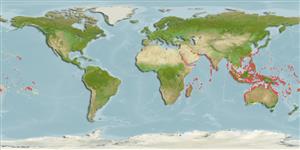>
Eupercaria/misc (Various families in series Eupercaria) >
Scaridae (Parrotfishes) > Sparisomatinae
Etymology: Leptoscarus: Greek, leptos = thin + Latin, scarus = a fish cited by ancient writers; 1601 (Ref. 45335).
More on authors: Quoy & Gaimard.
Environment: milieu / climate zone / depth range / distribution range
Ecología
marino asociado a arrecife; rango de profundidad 1 - 15 m (Ref. 86942). Tropical; 30°N - 36°S, 18°E - 108°W
Indo-Pacific: northern Red Sea and South Africa to Easter Island, north to southern Japan, south to Poor Knight's Island in New Zealand and Rottnest Island in Australia. Southeast Atlantic: False Bay, South Africa (Ref. 525).
Tamaño / Peso / Age
Maturity: Lm ? range ? - ? cm
Max length : 35.2 cm TL macho / no sexado; (Ref. 125598); peso máximo publicado: 657.00 g (Ref. 125598)
Espinas dorsales (total): 9; Radios blandos dorsales (total): 10; Espinas anales 3; Radios blandos anales: 9; Vértebra: 25. This species distinguished by the following characters: median predorsal scales 4 (occasionally 3); 1 scale row on cheek, 1(4), below eye; pectoral-fin rays 13; relatively elongate, its depth 2.9-3.8 in SL; unique narrow dental plates composed of numerous small teeth. Colour when fresh, greenish or olive brown, often strongly mottled; male with midlateral white stripe (Ref. 9793, 90102).
Found in sheltered bays, harbors and lagoons (Ref. 48636). Inhabits seagrass areas or areas with hard substrates heavy with algal cover. Usually occur in small groups. Unlike other parrotfishes, males and females look very similar and do not change sex (Ref. 48636). Feeds on seagrasses and algae (Ref. 30573). Marketed fresh (Ref. 5284).
Life cycle and mating behavior
Madurez | Reproducción | Puesta | Huevos | Fecundidad | Larva
Spawns in shallow water above grassflats on the falling tide. Investigation of sexual identity of large samples suggest the species is gonochoristic (sex-reversal do not occur), the first sparid species known to be so (Ref. 1875). Also Ref. 103751.
Bruce, R.W. and J.E. Randall, 1985. A revision of the Indo-West Pacific parrotfish genera Calotomus and Leptoscarus (Scaridae: Sparisomatinae). Indo-Pac. Fish. (5):32 p. (Ref. 525)
IUCN Red List Status (Ref. 130435)
Threat to humans
Harmless
Human uses
Pesquerías: comercial; Acuario: Comercial
Más información
ReferenciasAcuiculturaPerfil de acuiculturaRazasGenéticaElectrophoresesheritabilidadEnfermedadesProcesamientoNutrientsMass conversion
ColaboradoresImágenesStamps, Coins Misc.SonidosCiguateraVelocidadTipo de nataciónSuperficie branquialOtolitosCerebrosVisión
Herramientas
Special reports
Download XML
Fuentes de Internet
Estimates based on models
Preferred temperature (Ref.
123201): 24.3 - 29.3, mean 28.2 °C (based on 2909 cells).
Phylogenetic diversity index (Ref.
82804): PD
50 = 1.0000 [Uniqueness, from 0.5 = low to 2.0 = high].
Bayesian length-weight: a=0.00891 (0.00593 - 0.01340), b=3.01 (2.89 - 3.13), in cm total length, based on LWR estimates for this species & (Sub)family-body (Ref.
93245).
Nivel trófico (Ref.
69278): 2.0 ±0.0 se; based on diet studies.
Resiliencia (Ref.
120179): Alto, población duplicada en un tiempo mínimo inferior a 15 meses (Preliminary K or Fecundity.).
Prior r = 1.20, 95% CL = 0.79 - 1.80, Based on 1 stock assessment.
Fishing Vulnerability (Ref.
59153): Low to moderate vulnerability (25 of 100).
Nutrients (Ref.
124155): Calcium = 56.7 [33.8, 108.2] mg/100g; Iron = 0.738 [0.398, 1.243] mg/100g; Protein = 18.6 [16.5, 20.4] %; Omega3 = 0.0974 [, ] g/100g; Selenium = 27.8 [16.2, 52.4] μg/100g; VitaminA = 51.4 [15.8, 168.9] μg/100g; Zinc = 1.76 [1.20, 2.80] mg/100g (wet weight);
